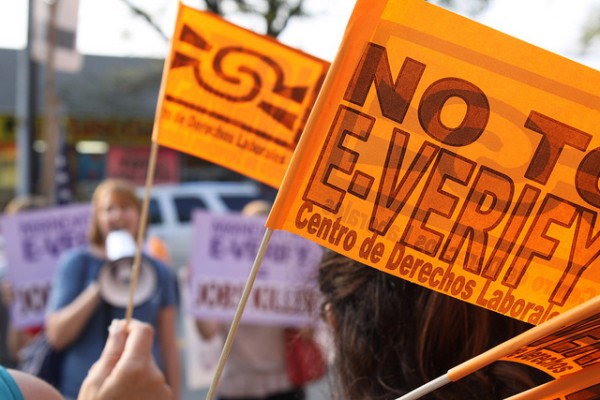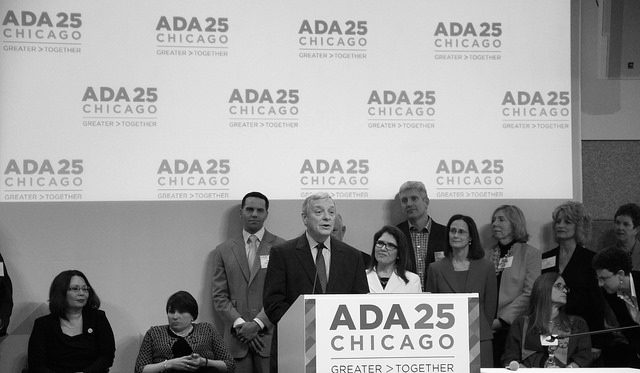
Originally published July 26, 2015
People with developmental and intellectual disabilities face many obstacles in getting access to the same rights and opportunities as people without disabilities. Depending on the state where they live, Americans with intellectual and developmental disabilities have a number of options to find suitable employment. Various state agencies work together with the Department of Rehabilitation, social workers, and other supportive groups to help disabled people hold jobs that make them self-sufficient. “Employment First” is the goal for a growing movement of advocates and officials who see this as the best route forward for disabled adults, but a closer look at the realities suggests that many disabled people need extra support along with jobs.
Employment First proponents claim that individuals with developmental and intellectual disabilities have a right to work in the community at the same wages as other employees. Although this is a worthy claim, individuals suffering from disabilities often need supported employment. They can benefit from job coaches or other trained professionals who can assist them in finding and holding posts. And such extra help may need funding, because many employers are reluctant to pay equal wages to people who often need extra support.
Legal Changes and Looming Challenges
Heretofore, many disabled clients have been employed at group sites holding contracts to provide services such as janitorial or landscaping work. Revenues from the contracts pay for client wages, supplies, and the services of job coaches. But recently word came down that governmental agencies will soon require that disabled clients earn at least minimum wages – a situation that leaves many organizations helping people with developmental disabilities worried about adequate funds to cover the increased wage costs.
In response, advocates are now urging increases in funding for agencies that provide services to clients with developmental disabilities. However, if this quest for extra funding falls short, group job sites providing opportunities for workers with developmental disabilities may be unable to cope with new costs. Contracts could be lost, thus leaving persons with developmental disabilities without employment.
Confusion in Store for Many of the Developmentally Disabled
Various sheltered workshops are closing due to governmental mandates – and that can be a very traumatic and confusing experience for workers with developmental and intellectual disabilities. When workshops close, attempts are made to procure employment for as many clients as possible in the larger community. But it is often difficult to find such regular jobs, leaving quite a few people with developmental and intellectual disabilities at risk of persistent unemployment. That, in turn can lead to depression, because many disabled people, like others, find self-esteem and dignity in work and the accompanying daily routines.
Persons with developmental disabilities are often creatures of habit who find reassurance in routine. For decades, many of them have been working in the same workshop or at the same group site. To close down such settings can spur widespread trauma. Professionals need to consider the cognitive levels of the individuals they serve and take into account just how much disruption people can handle. Even if changes are for the benefit of many people with developmental disabilities, are the costs in emotional trauma and loss of jobs for others worth it? Some developmentally disabled people do not even understand the concept of money or understand how to earn and spend wages like others in the community. What the severely disabled do comprehend is how they are treated when they are allowed to work like others they know. In our society, what people do for a living becomes central to their identities and this is just as true for the disabled as for others. Hardly anyone could cope with having such a core part of their identity stripped away, yet current changes in public policy threaten exactly that for many severely developmentally disabled Americans.
The Search for Solutions
However, there are two sides to every set of new problems and challenges. Many advocates for the disabled deplore the idea that disabled workers should be paid sub-minimum wages. They see this as exploitative, and pressures from them help to explain the public policy changes now happening. But even if the basic argument here is correct, there are risks as well if the new rules about prevailing wages force developmentally disabled workers out of any jobs at all.
Are there good solutions to the new dilemmas? Many of the sheltered workshops perform time studies where a client is tested next to a supposedly typical worker. They set lower prevailing wages for disabled people depending on their percentage of the productivity of non-disabled workers. But these tests take about five minutes and consist of timing the client to see how fast they can perform a certain task. Is it really fair to set lower hourly or daily wages this way, given that in real workplaces, many employees slow down for stretches or take breaks?
Much more research and professional consultation is needed to work out these issues, but the challenge is arduous. Given variations in federal and state policies, what works for one state may not comply with regulations in other states. Devising and implementing new ways to support disabled workers within the new wage rules will be a balancing act among the states and between the states and the federal government.
Clearly, Americans with developmental disabilities have the right to work and to earn fair wages like others in society. But researchers and caring professionals have a ways to go to find the best ways to achieve this goal. Fresh ideas are needed, and extra funding is bound to be required from public agencies and nonprofit groups as well as businesses, if the United States is to do right for its disabled citizens, including those who are developmentally hindered and thus especially vulnerable.





 Research to Improve Policy: The Scholars Strategy Network seeks to improve public policy and strengthen democracy by organizing scholars working in America's colleges and universities. SSN's founding director is Theda Skocpol, Victor S. Thomas Professor of Government and Sociology at Harvard University.
Research to Improve Policy: The Scholars Strategy Network seeks to improve public policy and strengthen democracy by organizing scholars working in America's colleges and universities. SSN's founding director is Theda Skocpol, Victor S. Thomas Professor of Government and Sociology at Harvard University.